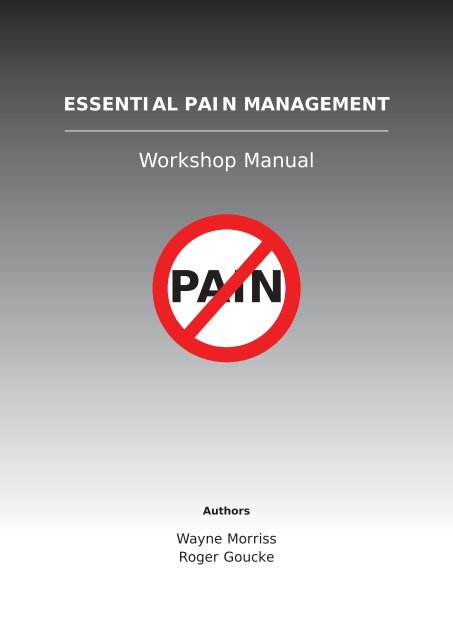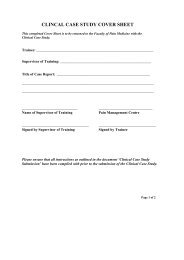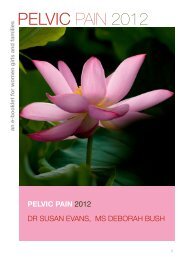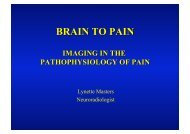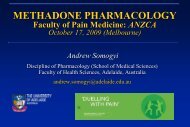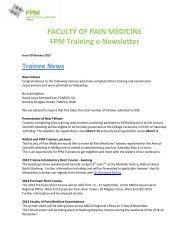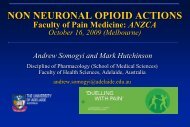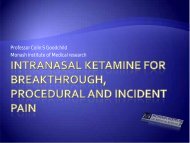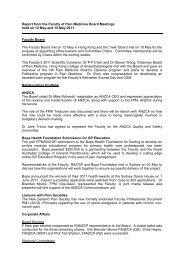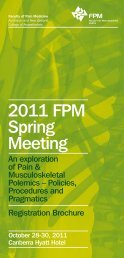Workshop Manual - Faculty of pain medicine - Australian and New ...
Workshop Manual - Faculty of pain medicine - Australian and New ...
Workshop Manual - Faculty of pain medicine - Australian and New ...
You also want an ePaper? Increase the reach of your titles
YUMPU automatically turns print PDFs into web optimized ePapers that Google loves.
ESSENTIAL PAIN MANAGEMENT<br />
<strong>Workshop</strong> <strong>Manual</strong><br />
PAIN<br />
Authors<br />
Wayne Morriss<br />
Roger Goucke
ESSENTIAL PAIN MANAGEMENT<br />
A <strong>Workshop</strong> for Health Workers<br />
1st Edition<br />
2011<br />
Wayne Morriss<br />
Anaesthetist<br />
Christchurch, <strong>New</strong> Zeal<strong>and</strong><br />
Roger Goucke<br />
Pain Medicine Physician<br />
Perth, Western Australia<br />
The Essential Pain Management Course has been developed with the<br />
support <strong>of</strong> the <strong>Faculty</strong> <strong>of</strong> Pain Medicine, <strong>Australian</strong> <strong>and</strong> <strong>New</strong> Zeal<strong>and</strong> College<br />
<strong>of</strong> Anaesthetists
Essential Pain Management by Wayne Morriss <strong>and</strong> Roger Goucke<br />
is licensed under a Creative Commons Attribution-NonCommercial<br />
3.0 Unported License.<br />
http://creativecommons.org/licenses/by-nc/3.0/<br />
You are free to share (copy, distribute <strong>and</strong> transmit the work)<br />
<strong>and</strong> to remix (to adapt the work). You must attribute the work<br />
(give the original authors credit). You may not use this work for<br />
commercial purposes. For any reuse or distribution, you must<br />
make clear to others the license terms <strong>of</strong> this work. Any <strong>of</strong> the<br />
above conditions can be waived if you get permission from the<br />
copyright holder.<br />
Title - Essential Pain Management<br />
Subtitle: <strong>Workshop</strong> <strong>Manual</strong><br />
ISBN: 978-0-646-55351-1<br />
Format: Paperback<br />
Publication Date: 03/2011<br />
Acknowledgements<br />
We wish to acknowledge the <strong>Australian</strong> <strong>and</strong> <strong>New</strong> Zeal<strong>and</strong> College <strong>of</strong> Anaesthetists for<br />
supporting the development <strong>of</strong> this course.<br />
We are also grateful for the support <strong>of</strong> the Ronald Ge<strong>of</strong>frey Arnott Foundation,<br />
the <strong>Australian</strong> Society <strong>of</strong> Anaesthetists, the World Federation <strong>of</strong> Societies <strong>of</strong><br />
Anaesthesiologists <strong>and</strong> the International Association for the Study <strong>of</strong> Pain.<br />
We thank our colleagues for their advice <strong>and</strong> help with course materials, especially<br />
Max Sarma <strong>and</strong> Haydn Perndt (Australia), Gertrude Marun <strong>and</strong> Harry Aigeeleng<br />
(Papua <strong>New</strong> Guinea), Luke Nasedra (Fiji) <strong>and</strong> Kaeni Agiomea (Solomon Isl<strong>and</strong>s). We<br />
also thank River Gibson for drawing the diagrams <strong>and</strong> Diane Perndt for her help with<br />
formatting this book.<br />
Disclaimer<br />
We have done our best to provide accurate information regarding drug doses <strong>and</strong><br />
other treatments, however this book may contain mistakes. In addition, treatment<br />
options vary from country to country. It is important that health workers doublecheck<br />
drug doses <strong>and</strong> use their clinical judgement when treating patients.
CONTENTS<br />
4 Introduction<br />
5 What is Pain<br />
6 Why Should We Treat Pain<br />
8 Classification <strong>of</strong> Pain<br />
10 Physiology <strong>and</strong> Pathology<br />
18 Pain Treatment<br />
25 Barriers to Pain Treatment<br />
27 Basic Approach to Pain Management<br />
– Recognize<br />
– Assess<br />
– Treat<br />
31 Assessment <strong>of</strong> Severity<br />
32 Pain Management Examples<br />
42 Case Discussions<br />
46 Discussion Topics<br />
APPENDICES<br />
48 Appendix 1: WHO Essential Medicines List<br />
50 Appendix 2: Medicine Formulary for Adults<br />
54 Appendix 3: Paediatric Medicine Doses<br />
55 Appendix 4: WHO Analgesic Ladder<br />
56 Appendix 5: Using Morphine for Cancer Pain<br />
ESSENTIAL PAIN MANAGEMENT 3
INTRODUCTION<br />
Pain affects all <strong>of</strong> us – young <strong>and</strong> old, rich <strong>and</strong> poor. Pain has many<br />
causes – cancer, injury, infection, surgery – <strong>and</strong> people experience<br />
<strong>pain</strong> in many different ways.<br />
Pain is <strong>of</strong>ten a “hidden” problem <strong>and</strong> is <strong>of</strong>ten poorly treated. We do<br />
not always recognise that a person is in <strong>pain</strong>. There are also many<br />
barriers to the treatment <strong>of</strong> <strong>pain</strong> – e.g. people’s attitudes, lack <strong>of</strong><br />
health workers <strong>and</strong> lack <strong>of</strong> <strong>medicine</strong>s.<br />
Pain can <strong>of</strong>ten be improved with very simple treatments.<br />
In some ways, <strong>pain</strong> is like a rat – something that causes a lot <strong>of</strong><br />
suffering but is <strong>of</strong>ten hidden from view.<br />
The letters R.A.T. can also be used to help us manage <strong>pain</strong>:<br />
R = Recognize<br />
A = Assess<br />
T = Treat<br />
The basic aims <strong>of</strong> this course are:<br />
• To improve underst<strong>and</strong>ing <strong>of</strong> <strong>pain</strong><br />
• To teach a simple framework for managing <strong>pain</strong><br />
• To reduce <strong>pain</strong> management barriers<br />
4 ESSENTIAL PAIN MANAGEMENT
WHAT IS PAIN<br />
Think <strong>of</strong> a patient/friend/relative who had <strong>pain</strong>. How did<br />
the person describe the <strong>pain</strong> How was it treated<br />
The International Association for the Study <strong>of</strong> Pain defines <strong>pain</strong> in the<br />
following way:<br />
Pain is “an unpleasant sensory <strong>and</strong> emotional experience<br />
associated with actual or potential tissue damage, or<br />
described in terms <strong>of</strong> such damage”.<br />
This definition is quite complicated but some important points can<br />
be made:<br />
• Pain is unpleasant <strong>and</strong> therefore, in general, people do<br />
not like having <strong>pain</strong>.<br />
• Emotions (psychological aspects) are important.<br />
• Pain is not always associated with visible tissue damage.<br />
In other words, a patient may be experiencing <strong>pain</strong> even<br />
if we cannot see an obvious cause for it.<br />
Another simpler definition <strong>of</strong> <strong>pain</strong> is:<br />
“Pain is what the person says hurts.”<br />
WHAT IS PAIN<br />
ESSENTIAL PAIN MANAGEMENT 5
WHY SHOULD WE TREAT PAIN<br />
CASE 1:<br />
Mr T is a 29-year-old man with a fast growing mouth cancer that<br />
has spread to his bones. He has severe face <strong>pain</strong>. He is expected to<br />
die within 6 months <strong>and</strong> the surgeons do not want to operate. He<br />
is married with two children, aged 11 <strong>and</strong> 8.<br />
Why should we treat his <strong>pain</strong><br />
CASE 2:<br />
Mrs G is a 54-year-old woman who has just had a laparotomy for<br />
bowel obstruction. You see her on the surgical ward soon after the<br />
operation. She appears to be in <strong>pain</strong>.<br />
Why should we treat her <strong>pain</strong><br />
WHY TREAT PAIN<br />
6 ESSENTIAL PAIN MANAGEMENT
Acute <strong>pain</strong> is a symptom <strong>of</strong> tissue injury. Untreated <strong>pain</strong> causes<br />
inflammatory changes in the body which may have harmful physical<br />
<strong>and</strong> psychological effects. In addition, poorly treated acute <strong>pain</strong> may<br />
progress to chronic <strong>pain</strong>.<br />
There are benefits <strong>of</strong> effective <strong>pain</strong> management for both the patient,<br />
the patient’s family, <strong>and</strong> society (hospital <strong>and</strong> wider community).<br />
For the patient:<br />
• Treating <strong>pain</strong> is the “humane” thing to do<br />
— Less suffering<br />
— Greater dignity (especially for patients dying with<br />
cancer <strong>pain</strong>)<br />
• Fewer physical problems<br />
— Improved sleep, better appetite<br />
— Quicker recovery after injury or surgery<br />
— Lower risk <strong>of</strong> pneumonia<br />
(e.g. after abdominal surgery)<br />
— Lower risk <strong>of</strong> thrombosis if able to mobilise earlier<br />
• Fewer psychological problems<br />
— Less depression <strong>and</strong> anxiety<br />
For the family:<br />
• Able to function as part <strong>of</strong> the family<br />
• Able to provide for the family<br />
For society:<br />
• Lower health costs<br />
— Patients are discharged earlier<br />
— Patients are less likely to be readmitted<br />
• Patients are able to work <strong>and</strong> contribute to the community<br />
WHY TREAT PAIN<br />
ESSENTIAL PAIN MANAGEMENT 7
CLASSIFICATION OF PAIN<br />
Not all <strong>pain</strong> is the same.<br />
It is important to classify the <strong>pain</strong> (make a <strong>pain</strong> diagnosis) because<br />
this helps us to choose the best treatment.<br />
Pain can be classified in many ways, but it is helpful to classify <strong>pain</strong><br />
using three main questions:<br />
1. How long has the patient had <strong>pain</strong><br />
2. What is the cause<br />
3. What is the <strong>pain</strong> mechanism<br />
1. Acute versus chronic <strong>pain</strong> (duration)<br />
Pain can be acute (<strong>pain</strong> for less than 3 months) or chronic (<strong>pain</strong> for<br />
more than 3 months or persisting after an injury heals). Sometimes,<br />
a patient with chronic <strong>pain</strong> may experience additional acute <strong>pain</strong><br />
(acute on chronic <strong>pain</strong>).<br />
There is evidence that poorly treated acute <strong>pain</strong> is more likely to<br />
become chronic <strong>pain</strong>.<br />
2. Cancer versus non-cancer <strong>pain</strong> (cause)<br />
Cancer <strong>pain</strong><br />
• Examples include pelvic <strong>pain</strong> due to uterine cervical<br />
cancer, bone <strong>pain</strong> due to cancer spread to bones.<br />
• Pain symptoms tend to get worse over time if untreated<br />
(i.e. progressive)<br />
• Often cancer <strong>pain</strong> is chronic but the patient may get<br />
acute <strong>pain</strong> as well (e.g. <strong>pain</strong> due to a new fracture from<br />
bone metastases)<br />
Non-cancer <strong>pain</strong><br />
CLASSIFICATION OF PAIN<br />
• There are many different causes, including:<br />
— Surgery or injury<br />
— Degenerative disease (e.g. arthritis)<br />
— Headache<br />
— Childbirth<br />
8 ESSENTIAL PAIN MANAGEMENT
— Nerve compression or injury<br />
(e.g. sciatica, "neuralgia”)<br />
— No obvious cause (“psychological”)<br />
• Pain may be acute <strong>and</strong> last for a limited time or may<br />
become chronic.<br />
• The cause may or may not be obvious.<br />
3. Nociceptive versus neuropathic <strong>pain</strong> (mechanism)<br />
Pain can also be classified by mechanism (the physiological or<br />
pathological way the <strong>pain</strong> is produced). There is currently much<br />
research in this area – underst<strong>and</strong>ing the exact cause <strong>of</strong> <strong>pain</strong> at the<br />
nerve level will help guide more specific treatments.<br />
The <strong>pain</strong> can either be nociceptive, neuropathic or mixed (both<br />
nociceptive <strong>and</strong> neuropathic). Nociceptive <strong>and</strong> neuropathic <strong>pain</strong> are<br />
also discussed in the Physiology <strong>and</strong> Pathology section.<br />
Nociceptive <strong>pain</strong><br />
• Commonest type <strong>of</strong> <strong>pain</strong> following tissue injury.<br />
• Sometimes called “physiological” <strong>pain</strong>.<br />
• Caused by stimulation <strong>of</strong> <strong>pain</strong> receptors in the tissues that<br />
have been injured.<br />
• Patients describe <strong>pain</strong> as sharp, throbbing or aching,<br />
<strong>and</strong> it is usually well localised (the patient is able to point<br />
to exactly where the <strong>pain</strong> is).<br />
Neuropathic <strong>pain</strong><br />
• Caused by damage to or abnormal function <strong>of</strong> the<br />
nervous system.<br />
• Sometimes called “pathological” <strong>pain</strong>.<br />
• Tissue injury may not be obvious.<br />
• Effects <strong>of</strong> nerve damage:<br />
— Abnormal firing <strong>of</strong> nerves giving <strong>pain</strong> without<br />
a stimulus.<br />
— Increased number <strong>of</strong> <strong>pain</strong> signals from the spinal<br />
cord to the brain.<br />
• Patients describe neuropathic <strong>pain</strong> as shooting or burning.<br />
They may also complain <strong>of</strong> numbness or pins <strong>and</strong><br />
needles. The <strong>pain</strong> is <strong>of</strong>ten not well localised.<br />
CLASSIFICATION OF PAIN<br />
ESSENTIAL PAIN MANAGEMENT 9
PHYSIOLOGY AND PATHOLOGY<br />
Underst<strong>and</strong>ing <strong>pain</strong> physiology <strong>and</strong> pathology helps us to underst<strong>and</strong><br />
how to treat <strong>pain</strong>.<br />
Normal <strong>pain</strong> physiology involves a number <strong>of</strong> steps between the site<br />
<strong>of</strong> injury <strong>and</strong> the brain – this is called the “<strong>pain</strong> pathway” (Fig 1). The<br />
<strong>pain</strong> signal can be changed at many points along the <strong>pain</strong> pathway,<br />
e.g. by drugs or psychological factors. These changes affect the<br />
amount <strong>and</strong> type <strong>of</strong> <strong>pain</strong> we feel.<br />
Pain pathology involves damage to or abnormality <strong>of</strong> the <strong>pain</strong><br />
pathway. This can cause neuropathic <strong>pain</strong>.<br />
Nociception <strong>and</strong> <strong>pain</strong><br />
Nociception is how <strong>pain</strong> signals get from the site <strong>of</strong> injury to the<br />
brain. Nociception can be altered by many factors – in the periphery,<br />
in the spinal cord <strong>and</strong> in the brain.<br />
Nociception is not the same as <strong>pain</strong> perception (how we “feel” <strong>pain</strong>).<br />
Pain perception depends on many other factors, including:<br />
• Beliefs / concerns about <strong>pain</strong><br />
• Psychological factors (e.g. anxiety, anger)<br />
• Cultural expectations<br />
• Other illnesses<br />
• Coping strategies<br />
• Social factors (e.g. family, work)<br />
PHYSIOLOGY AND PATHOLOGY<br />
10 ESSENTIAL PAIN MANAGEMENT
Fig 1: The <strong>pain</strong> pathway<br />
PHYSIOLOGY AND PATHOLOGY<br />
ESSENTIAL PAIN MANAGEMENT 11
The <strong>pain</strong> pathway<br />
1. Periphery (Fig 2 <strong>and</strong> 3)<br />
• Tissue injury causes release <strong>of</strong> chemicals,<br />
the “inflammatory soup”<br />
(e.g. hydrogen ions, prostagl<strong>and</strong>ins).<br />
• These substances stimulate <strong>pain</strong> nerves (nociceptors)<br />
called Aδ <strong>and</strong> C fibres.<br />
• The body also responds to the damage by releasing<br />
inflammatory substances (e.g. substance P), which<br />
increase nociceptor stimulation.<br />
• The <strong>pain</strong> signal travels along the Aδ <strong>and</strong> C fibres, through<br />
the dorsal root to the dorsal horn <strong>of</strong> the spinal cord.<br />
PHYSIOLOGY AND PATHOLOGY<br />
12 ESSENTIAL PAIN MANAGEMENT
Fig 2: “Inflammatory soup” <strong>and</strong> stimulation <strong>of</strong> nociceptors<br />
Fig 3: Transmission <strong>of</strong> <strong>pain</strong> signal from the periphery to the dorsal horn<br />
PHYSIOLOGY AND PATHOLOGY<br />
ESSENTIAL PAIN MANAGEMENT 13
2. Spinal cord (Fig 4)<br />
• The dorsal horn <strong>of</strong> the spinal cord is the “first relay<br />
station”. This is a vital area for two main reasons:<br />
— The Aδ <strong>and</strong> C fibres connect (synapse) with<br />
“second order” <strong>pain</strong> nerves.<br />
— There is input from other peripheral <strong>and</strong> spinal<br />
cord nerves – this may change the signal.<br />
• The second order <strong>pain</strong> nerve crosses to the other side <strong>of</strong><br />
the spinal cord <strong>and</strong> travels up the spinothalamic tract to<br />
the thalamus at the base <strong>of</strong> the brain.<br />
PHYSIOLOGY AND PATHOLOGY<br />
Fig 4: Dorsal horn connections<br />
14 ESSENTIAL PAIN MANAGEMENT
3. Brain (Fig 5)<br />
• The thalamus is the “second relay station”. There are<br />
many connections with other parts <strong>of</strong> the brain, including:<br />
— Cortex<br />
— Limbic system<br />
— Brainstem<br />
• The cortex is the main area responsible for us being aware<br />
<strong>of</strong> the <strong>pain</strong> (i.e. <strong>pain</strong> perception).<br />
• The limbic system is responsible for many <strong>of</strong> the emotions<br />
we feel when we experience <strong>pain</strong> (e.g. anxiety, fear).<br />
Fig 5: Brain connections<br />
PHYSIOLOGY AND PATHOLOGY<br />
ESSENTIAL PAIN MANAGEMENT 15
4. Modulation (Fig 6)<br />
• The <strong>pain</strong> signals can be changed (modulated) in the spinal<br />
cord or the brain.<br />
• In the dorsal horn <strong>of</strong> the spinal cord, peripheral <strong>pain</strong><br />
nerves or spinal cord nerves can either increase (excite)<br />
or reduce (inhibit) <strong>pain</strong>.<br />
• The descending <strong>pain</strong> pathway is a very important<br />
inhibitory pathway. It travels from the brainstem down the<br />
spinal cord to the dorsal horn where it inhibits <strong>pain</strong> signals<br />
from the periphery.<br />
PHYSIOLOGY AND PATHOLOGY<br />
Fig 6: Descending <strong>pain</strong> modulation<br />
16 ESSENTIAL PAIN MANAGEMENT
What happens in neuropathic <strong>pain</strong><br />
In neuropathic <strong>pain</strong> (“pathological <strong>pain</strong>”), there is damage to or<br />
abnormal function <strong>of</strong> the peripheral or central nervous system.<br />
Examples:<br />
• Nerve damage caused by:<br />
— Trauma<br />
— Cancer<br />
— Amputation<br />
— Diabetes<br />
• Chronic <strong>pain</strong> following prolonged, poorly treated acute <strong>pain</strong><br />
Mechanisms:<br />
• Peripheral nervous system<br />
— Increased receptor numbers<br />
— Abnormal firing <strong>of</strong> <strong>pain</strong> nerves<br />
• Central nervous system<br />
— Changes in chemical signalling at the dorsal horn<br />
— “Rewiring” <strong>of</strong> nerve connections<br />
— Loss <strong>of</strong> normal inhibitory nerve function<br />
— The overall effect is called “central sensitisation”.<br />
Because <strong>of</strong> these changes, <strong>pain</strong> may occur spontaneously (no stimulus)<br />
or <strong>pain</strong> may result from stimuli that are normally non-<strong>pain</strong>ful (e.g.<br />
touch). Psychological changes (e.g. increased anxiety) will also<br />
contribute to the development <strong>of</strong> neuropathic <strong>pain</strong>.<br />
PHYSIOLOGY AND PATHOLOGY<br />
ESSENTIAL PAIN MANAGEMENT 17
PAIN TREATMENT<br />
Because many factors contribute to the amount <strong>and</strong> type <strong>of</strong> <strong>pain</strong><br />
we feel, it is <strong>of</strong>ten necessary to use a combination <strong>of</strong> treatments to<br />
manage an individual patient’s <strong>pain</strong>.<br />
Both non-drug <strong>and</strong> drug treatments are important.<br />
What non-drug treatments are available where you work<br />
PAIN TREATMENT<br />
18 ESSENTIAL PAIN MANAGEMENT
What <strong>pain</strong> drugs (analgesics) are available where you<br />
work What doses <strong>and</strong> what preparations (e.g. injections,<br />
suppositories etc)<br />
PAIN TREATMENT<br />
ESSENTIAL PAIN MANAGEMENT 19
Non-drug treatments<br />
Both physical <strong>and</strong> psychological factors affect how we feel <strong>pain</strong>.<br />
Treatments include:<br />
• Physical<br />
— RICE (rest, ice, compression, elevation) <strong>of</strong> injuries<br />
— Surgery (e.g. for treatment <strong>of</strong> abscess)<br />
— Acupuncture, massage, physiotherapy<br />
• Psychological<br />
— Explanation<br />
— Reassurance<br />
— Counselling<br />
A placebo treatment involves giving a patient a <strong>medicine</strong> that has no<br />
pharmacological effect (e.g. giving an injection <strong>of</strong> saline for <strong>pain</strong>).<br />
Because psychological factors are very important, the patient’s <strong>pain</strong><br />
may improve.<br />
If the placebo treatment works, this does not mean the patient did<br />
not have <strong>pain</strong> in the first place or that the patient was lying!<br />
Drug treatments<br />
Medicines are <strong>of</strong>ten the mainstay <strong>of</strong> treatment. Different <strong>medicine</strong>s<br />
work on different parts <strong>of</strong> the <strong>pain</strong> pathway <strong>and</strong> it is <strong>of</strong>ten important<br />
to use a combination <strong>of</strong> <strong>medicine</strong>s. In addition, combining <strong>medicine</strong>s<br />
may result in fewer side effects, e.g. prescribing regular paracetamol<br />
in addition to morphine allows the dose <strong>of</strong> morphine to be reduced,<br />
resulting in fewer morphine-related side effects.<br />
PAIN TREATMENT<br />
20 ESSENTIAL PAIN MANAGEMENT
Classification <strong>of</strong> <strong>pain</strong> drugs (analgesics)<br />
Note: Refer to the appendices for individual drug information <strong>and</strong> doses.<br />
1. Simple analgesics<br />
• Paracetamol / acetaminophen (Pamol, Panadol, Tylenol)<br />
• Non-steroidal anti-inflammatory <strong>medicine</strong>s (NSAIMs)<br />
— Aspirin<br />
— Ibupr<strong>of</strong>en (Brufen, Nur<strong>of</strong>en)<br />
— Dicl<strong>of</strong>enac (Voltaren)<br />
2. Opioid analgesics<br />
• Mild opioid<br />
— Codeine<br />
• Strong opioid<br />
— Morphine<br />
— Pethidine (Demerol)<br />
3. Other analgesics<br />
• Tricyclic antidepressants<br />
— Amitriptyline<br />
• Anticonvulsants<br />
— Carbamazepine (Tegretol)<br />
— Sodium valproate (Epilim)<br />
• Local anaesthetics<br />
— Lignocaine / lidocaine (Xylocaine)<br />
— Bupivacaine (Marcain)<br />
• Others<br />
— Tramadol<br />
— Ketamine<br />
— Clonidine<br />
— Entonox (N₂O/O₂)<br />
PAIN TREATMENT<br />
ESSENTIAL PAIN MANAGEMENT 21
Where do analgesics work<br />
Local anaesthetics<br />
NSAIMs<br />
PAIN TREATMENT<br />
22 ESSENTIAL PAIN MANAGEMENT
How do analgesics work<br />
Simple analgesics<br />
Paracetamol<br />
NSAIMs<br />
Change prostagl<strong>and</strong>in levels in the brain<br />
Mainly work by changing prostagl<strong>and</strong>in levels in<br />
the periphery, thereby reducing inflammation<br />
Opioid analgesics<br />
Codeine<br />
Morphine, pethidine<br />
Acts on opioid receptors in the brain <strong>and</strong><br />
spinal cord<br />
Act on opioid receptors in the brain <strong>and</strong><br />
spinal cord<br />
Other analgesics<br />
Amitriptyline<br />
Anticonvulsants<br />
Local anaesthetics<br />
Tramadol<br />
Ketamine<br />
Increases descending inhibitory signals in the<br />
spinal cord<br />
“Membrane stabilisers”, probably work by<br />
reducing abnormal firing <strong>of</strong> <strong>pain</strong> nerves<br />
Temporarily block signalling in <strong>pain</strong> nerves in<br />
periphery (e.g. infiltration or nerve block) or<br />
spinal cord (e.g. spinal block)<br />
Acts weakly on opioid receptors, also increases<br />
descending inhibitory signals in the spinal cord<br />
Blocks NMDA receptors in the brain <strong>and</strong> spinal<br />
cord (especially in dorsal horn)<br />
Clonidine<br />
Increases descending inhibitory signals in the<br />
spinal cord<br />
PAIN TREATMENT<br />
ESSENTIAL PAIN MANAGEMENT 23
Drug effectiveness<br />
The effectiveness <strong>of</strong> an individual analgesic drug depends on the type<br />
<strong>of</strong> <strong>pain</strong>.<br />
The WHO Analgesic Ladder (Appendix 4) was designed mainly for<br />
treatment <strong>of</strong> cancer <strong>pain</strong>, i.e. progressive <strong>pain</strong> requiring increasing<br />
medication. This stepwise approach does not work well for acute<br />
severe <strong>pain</strong> requiring immediate strong opioids (e.g. morphine).<br />
The ladder also does not work well for chronic non-cancer <strong>pain</strong> or<br />
neuropathic <strong>pain</strong>. In these situations, morphine is usually unhelpful.<br />
Amitriptyline <strong>and</strong> membrane stabilising drugs are much more likely<br />
to be effective.<br />
Table 1 shows the usefulness <strong>of</strong> some analgesic drugs for treating<br />
different types <strong>of</strong> <strong>pain</strong>.<br />
Acute<br />
nociceptive<br />
mild<br />
Acute<br />
nociceptive<br />
severe<br />
Paracetamol +++ ++<br />
(in<br />
combination)<br />
Acute<br />
neuropathic<br />
Chronic<br />
non-cancer<br />
+ + +<br />
Chronic<br />
cancer<br />
NSAIMs ++ ++ ± ±<br />
(e.g. bone<br />
<strong>pain</strong>)<br />
Codeine ++ + ±<br />
Morphine +++ ++ - +++<br />
Amitriptyline - - ++ ++ ++<br />
(e.g.<br />
neuropathic<br />
<strong>pain</strong>)<br />
Carbamazepine - - ++ + +<br />
(e.g.<br />
neuropathic<br />
<strong>pain</strong>)<br />
Table 1: Analgesic usefulness<br />
PAIN TREATMENT<br />
- Not usually useful<br />
± Occasionally useful<br />
+ Useful, mildly effective<br />
++ Useful, moderately effective<br />
+++ Useful, highly effective<br />
24 ESSENTIAL PAIN MANAGEMENT
BARRIERS TO PAIN TREATMENT<br />
Frequently, <strong>pain</strong> is not treated as well as it could be. Why does this<br />
happen<br />
What are the barriers where you work<br />
BARRIERS TO PAIN TREATMENT<br />
ESSENTIAL PAIN MANAGEMENT 25
Possible barriers:<br />
• Patient factors<br />
— Patients may expect to have <strong>pain</strong><br />
— Patients may not seek help<br />
— Patients may see complaining about <strong>pain</strong> as a<br />
weakness<br />
• Drugs<br />
— Supply may be unreliable<br />
— Appropriate drugs missing from the hospital formulary<br />
— Appropriate preparations not available (e.g. fast<br />
release oral morphine)<br />
• Health workers<br />
— Not enough workers<br />
— Workers too busy<br />
— Workers may not recognize <strong>pain</strong><br />
— Workers may have inadequate knowledge about <strong>pain</strong><br />
<strong>and</strong> its treatment<br />
— Workers may be unable to prescribe or give<br />
appropriate drugs<br />
• System issues<br />
— No culture <strong>of</strong> <strong>pain</strong> assessment <strong>and</strong> management<br />
— No protocols<br />
— No forms for recording <strong>pain</strong> (e.g. on post-op obs<br />
charts or routine vital signs charts)<br />
BARRIERS TO PAIN TREATMENT<br />
26 ESSENTIAL PAIN MANAGEMENT
BASIC APPROACH TO PAIN MANAGEMENT<br />
R = RECOGNIZE<br />
A = ASSESS<br />
T = TREAT<br />
1. RECOGNIZE<br />
We sometimes forget to ask whether the patient has <strong>pain</strong> <strong>and</strong><br />
sometimes patients don’t or can’t tell us. If you don’t look or ask,<br />
you don’t find!<br />
Does the patient have <strong>pain</strong><br />
• Ask<br />
• Look (frowning, moving easily or not, sweating)<br />
Do other people know the patient has <strong>pain</strong><br />
• Other health workers<br />
• Patient’s family<br />
BASIC APPROACH TO PAIN MANAGEMENT<br />
ESSENTIAL PAIN MANAGEMENT 27
2. ASSESS<br />
To treat <strong>pain</strong> better, we need to think about the cause <strong>and</strong> type <strong>of</strong> <strong>pain</strong>.<br />
We may be able to better treat the injury that is causing the <strong>pain</strong>. We<br />
may also be able to choose better drugs to treat the <strong>pain</strong> itself.<br />
• HOW SEVERE IS THE PAIN<br />
• What is the <strong>pain</strong> score<br />
— At rest<br />
— With movement<br />
• How is the <strong>pain</strong> affecting the patient<br />
— Can the patient move, cough<br />
— Can the patient work<br />
• MAKE A PAIN DIAGNOSIS!<br />
Is the <strong>pain</strong> acute or chronic<br />
The cause <strong>of</strong> acute nociceptive <strong>pain</strong> may be very obvious<br />
but chronic <strong>pain</strong> may be more complicated. In chronic <strong>pain</strong>,<br />
psychological factors may be more important <strong>and</strong> the <strong>pain</strong> may<br />
have both nociceptive <strong>and</strong> neuropathic features.<br />
The <strong>pain</strong> may be acute on chronic (e.g. fracture in a patient<br />
with chronic cancer <strong>pain</strong>).<br />
Is the <strong>pain</strong> cancer <strong>pain</strong> or non-cancer <strong>pain</strong><br />
Does the patient’s disease explain the <strong>pain</strong><br />
BASIC APPROACH TO PAIN MANAGEMENT<br />
There may be an obvious cause <strong>of</strong> the <strong>pain</strong> that requires specific<br />
treatment. For example:<br />
— Fracture needing splinting or surgery<br />
— Infection needing cleaning <strong>and</strong> antibiotics<br />
28 ESSENTIAL PAIN MANAGEMENT
Is the <strong>pain</strong> nociceptive, neuropathic or mixed<br />
Neuropathic <strong>pain</strong> is more likely in some situations:<br />
— Diabetes<br />
— Nerve injury (including amputation)<br />
— Chronic <strong>pain</strong><br />
Ask about specific symptoms:<br />
— Burning or shooting <strong>pain</strong><br />
— Pins <strong>and</strong> needles, numbness<br />
— Phantom limb <strong>pain</strong><br />
• WHAT OTHER FACTORS ARE CONTRIBUTING TO THE PAIN<br />
• Physical factors (other illnesses)<br />
• Psychological <strong>and</strong> social factors<br />
— Anger, anxiety, depression<br />
— Lack <strong>of</strong> social supports<br />
BASIC APPROACH TO PAIN MANAGEMENT<br />
ESSENTIAL PAIN MANAGEMENT 29
3. TREAT<br />
Treatment can be divided into non-drug <strong>and</strong> drug treatments. Both<br />
types <strong>of</strong> treatment are important.<br />
Many factors may be contributing to an individual patient’s <strong>pain</strong>, so<br />
there is no set list <strong>of</strong> treatments. The exact treatments will depend<br />
on the individual patient, the type <strong>of</strong> injury or disease, the type <strong>of</strong><br />
<strong>pain</strong> <strong>and</strong> other factors contributing to the <strong>pain</strong>.<br />
• NON-DRUG TREATMENTS<br />
• Physical<br />
— Rest, ice, compression <strong>and</strong> elevation <strong>of</strong> injuries (RICE)<br />
— Surgery may be required<br />
— Nursing care<br />
— Acupuncture, massage, physiotherapy<br />
• Psychological<br />
— Explanation <strong>and</strong> reassurance<br />
— Input from social worker or pastor, if appropriate<br />
• DRUG TREATMENTS<br />
• Nociceptive <strong>pain</strong><br />
— The WHO Analgesic Ladder is helpful for mild to<br />
moderate <strong>pain</strong>.<br />
— Start with regular simple drugs (paracetamol ± NSAIM)<br />
— Add in codeine or morphine early if moderate to severe<br />
<strong>pain</strong> or simple drugs are inadequate<br />
— In severe <strong>pain</strong>, if possible, use small doses <strong>of</strong><br />
morphine IV to control <strong>pain</strong> early.<br />
BASIC APPROACH TO PAIN MANAGEMENT<br />
• Neuropathic <strong>pain</strong><br />
— The WHO Analgesic Ladder may not work as well<br />
— Consider using a tricyclic antidepressant (amitriptyline)<br />
or anticonvulsant (carbamazepine) early.<br />
— Don’t forget non-drug treatments<br />
30 ESSENTIAL PAIN MANAGEMENT
ASSESSMENT OF SEVERITY<br />
It is important to assess the severity <strong>of</strong> the <strong>pain</strong> to help guide<br />
treatment.<br />
Determine the <strong>pain</strong> score by using a number score or faces score. It is<br />
important to assess the <strong>pain</strong> score at rest <strong>and</strong> with movement (some<br />
patients will appear to have mild <strong>pain</strong> at rest but be unable to move<br />
because <strong>of</strong> severe <strong>pain</strong>).<br />
How is the <strong>pain</strong> affecting the patient Examples:<br />
• Post-laparotomy patient<br />
— Can the patient cough, get out <strong>of</strong> bed, walk<br />
• Chronic cancer patient<br />
— Can the patient look after himself / herself<br />
at home Work<br />
Number score<br />
Ask the patient to show where their <strong>pain</strong> comes on the scale <strong>of</strong> 1-10<br />
no <strong>pain</strong><br />
moderate <strong>pain</strong><br />
worst possible <strong>pain</strong><br />
Faces score<br />
Ask the patient to point to the face which shows how bad their <strong>pain</strong> is<br />
ASSESSMENT OF SEVERITY<br />
ESSENTIAL PAIN MANAGEMENT 31
PAIN MANAGEMENT EXAMPLES<br />
EXAMPLE 1:<br />
32-year-old man with compound fractured h<strong>and</strong><br />
1. RECOGNIZE<br />
• Pain easily recognized<br />
• Obvious cause, patient likely to be distressed<br />
2. ASSESS<br />
• Pain may be moderate to severe<br />
• Acute <strong>pain</strong>, musculoskeletal (non-cancer) cause<br />
• Nociceptive mechanism, <strong>pain</strong> described as sharp, aching<br />
• Possibility <strong>of</strong> neuropathic <strong>pain</strong> if nerve injury<br />
• Other factors may be contributing to the <strong>pain</strong><br />
(e.g. anxiety, infection if old injury)<br />
3. TREAT<br />
Summary<br />
• Non-drug treatments<br />
— Reduce inflammation (immobilisation, sling)<br />
— Surgery will probably be necessary<br />
— Prevention or treatment <strong>of</strong> infection<br />
• Drug treatments<br />
— Pain will be improved by simple drugs<br />
(e.g. paracetamol) but may need to add other drugs<br />
— Regular paracetamol (1G four times daily)<br />
— Consider adding codeine (30-60mg four-hourly)<br />
— NSAIMs will reduce inflammation but may affect<br />
bone healing<br />
— Morphine is effective <strong>and</strong> may be necessary if<br />
severe <strong>pain</strong><br />
PAIN MANAGEMENT EXAMPLES<br />
Moderate to severe, acute <strong>pain</strong> due to injury, nociceptive<br />
mechanism<br />
• Treat the injury<br />
• Regular simple analgesics<br />
• Morphine if severe <strong>pain</strong><br />
32 ESSENTIAL PAIN MANAGEMENT
EXAMPLE 2:<br />
8-year-old boy with probable appendicitis waiting for an<br />
operation.<br />
1. RECOGNIZE<br />
• Pain may be overlooked by health workers.<br />
• Ask the patient!<br />
2. ASSESS<br />
• Pain may be moderate to severe<br />
• Acute <strong>pain</strong>, non-cancer cause<br />
• Nociceptive mechanism but <strong>pain</strong> may not be well localised<br />
in early appendicitis.<br />
• Other factors may be contributing to the <strong>pain</strong> (e.g. fear,<br />
anxiety)<br />
3. TREAT<br />
• Non-drug treatments<br />
— Early surgery if possible<br />
— Reassurance<br />
— Support from family<br />
• Drug treatments<br />
— Drugs may not be well absorbed if given PO<br />
— Pain will be improved by simple drugs<br />
(e.g. paracetamol 15 mg/kg PO or PR 4-hourly)<br />
— Will probably need to add other drugs<br />
(e.g. codeine 0.5 mg/kg)<br />
— For severe <strong>pain</strong>, an IV should be inserted <strong>and</strong><br />
morphine given IV (0.02 mg/kg 10-minutely,<br />
e.g. 0.5 mg IV 10-minutely for a 25kg boy)<br />
Summary<br />
Moderate to severe, acute nociceptive <strong>pain</strong><br />
• Surgery needed<br />
• Regular simple analgesics<br />
• Morphine if severe <strong>pain</strong>, given IV if possible<br />
PAIN MANAGEMENT EXAMPLES<br />
ESSENTIAL PAIN MANAGEMENT 33
EXAMPLE 3:<br />
24-year-old woman with a 2 year history <strong>of</strong> severe<br />
headache. Doctors told her 6 months ago that there is<br />
“nothing wrong inside her head”.<br />
1. RECOGNIZE<br />
• Patient may not show outward signs <strong>of</strong> <strong>pain</strong><br />
• Other people may think that she doesn’t have <strong>pain</strong><br />
• Ask the patient!<br />
“Pain is what the patient says hurts.”<br />
2. ASSESS<br />
• Pain may be severe despite outward appearances<br />
• Chronic <strong>pain</strong>, non-cancer cause<br />
• There will probably be no obvious underlying disease. It is<br />
important to rule out increased intracranial pressure<br />
as a cause (e.g. due to brain tumour). Features <strong>of</strong><br />
increased intracranial pressure include early morning<br />
headache, nausea <strong>and</strong> vomiting, reduced level <strong>of</strong><br />
consciousness, <strong>and</strong> papilloedema on eye examination.<br />
• The <strong>pain</strong> may be difficult to localise <strong>and</strong> may have<br />
neuropathic features (e.g. burning, pins <strong>and</strong> needles)<br />
• Psychological <strong>and</strong> social factors may be contributing to the<br />
<strong>pain</strong>. It is important to ask about these.<br />
3. TREAT<br />
• Non-drug treatments<br />
— Reassurance that the <strong>pain</strong> is not due to anything<br />
life-threatening<br />
— Acupuncture <strong>and</strong> massage may be helpful<br />
— Psychological or social support are likely to be the<br />
mainstays <strong>of</strong> treatment.<br />
• Work issues<br />
• Family issues<br />
PAIN MANAGEMENT EXAMPLES<br />
• Drug treatments<br />
— Regular paracetamol <strong>and</strong> NSAIM may be helpful<br />
— In general, opiods are not helpful<br />
— Consider amitriptyline if features <strong>of</strong> neuropathic <strong>pain</strong><br />
(especially if poor sleep)<br />
34 ESSENTIAL PAIN MANAGEMENT
Summary<br />
Moderate to severe, chronic headache (non-cancer) <strong>pain</strong>,<br />
neuropathic mechanism<br />
• Assessment may be difficult<br />
• Non-drug treatments are important<br />
• Regular simple analgesics may help<br />
• Opioids not helpful<br />
• Amitriptyline may be helpful<br />
PAIN MANAGEMENT EXAMPLES<br />
ESSENTIAL PAIN MANAGEMENT 35
EXAMPLE 4:<br />
12-year-old girl with burns to chest <strong>and</strong> abdomen.<br />
She needs dressing changes every 2-3 days.<br />
1. RECOGNIZE<br />
• Patient may not appear to be in <strong>pain</strong> between dressing<br />
changes.<br />
• She may be very fearful <strong>of</strong> the dressing changes.<br />
• Staff on a burns ward will usually recognize that the<br />
patient has <strong>pain</strong>.<br />
2. ASSESS<br />
• Pain may be moderate to severe, especially when old<br />
dressings removed.<br />
• Acute <strong>pain</strong>, non-cancer cause<br />
• Usually nociceptive mechanism but may have some<br />
neuropathic features if the burns have caused nerve<br />
damage.<br />
• Psychological factors (e.g. fear <strong>and</strong> anxiety) will be<br />
contributing to the <strong>pain</strong>.<br />
• Physical factors (e.g. infection <strong>of</strong> burns) may also be<br />
contributing.<br />
3. TREAT<br />
• Non-drug treatments<br />
— Reassurance (“we can help the <strong>pain</strong>”, “your burns<br />
are healing well”)<br />
— Support from family, distraction<br />
— Patient may be able to remove own dressings<br />
— Surgery may be required<br />
PAIN MANAGEMENT EXAMPLES<br />
• Drug treatments<br />
— Fast release oral morphine 30 minutes before dressing<br />
change (0.3 mg/kg, e.g. 9 mg for a 30-kg girl)<br />
— Oral ketamine may be useful for very <strong>pain</strong>ful dressing<br />
changes (up to 5 mg/kg given 30 minutes before)<br />
— Entonox is sometimes helpful<br />
— Regular oral paracetamol <strong>and</strong> morphine if there is<br />
<strong>pain</strong> between dressing changes<br />
— Low dose amitriptyline (e.g. 5-10 mg at night) may<br />
be helpful if severe burn<br />
36 ESSENTIAL PAIN MANAGEMENT
Summary<br />
Moderate to severe, acute burn (non-cancer) <strong>pain</strong>, usually<br />
nociceptive<br />
• Fear <strong>and</strong> anxiety about dressing changes<br />
• Reassurance <strong>and</strong> other non-drug treatments are<br />
important<br />
• Oral morphine is the best drug treatment<br />
• Regular paracetamol <strong>and</strong> oral morphine if there<br />
is <strong>pain</strong> between dressing changes<br />
PAIN MANAGEMENT EXAMPLES<br />
ESSENTIAL PAIN MANAGEMENT 37
EXAMPLE 5:<br />
51-year-old man with 2 year history <strong>of</strong> lower back <strong>pain</strong>.<br />
Sometimes radiates down his right leg. Fell recently <strong>and</strong><br />
now having problems walking.<br />
1. RECOGNIZE<br />
• Patient may not show outward signs <strong>of</strong> <strong>pain</strong><br />
• Other people may think that the patient is avoiding work.<br />
• Ask the patient about his symptoms!<br />
2. ASSESS<br />
• Pain may be moderate to severe<br />
• Chronic <strong>pain</strong>, musculoskeletal (non-cancer) cause<br />
• There may have been a recent new injury causing acute on<br />
chronic <strong>pain</strong>.<br />
• The <strong>pain</strong> may be difficult to localise <strong>and</strong> have both<br />
nociceptive <strong>and</strong> neuropathic features (e.g. burning, pins<br />
<strong>and</strong> needles)<br />
• Multiple factors may be contributing to the <strong>pain</strong><br />
— Physical<br />
— Psychological <strong>and</strong> social<br />
3. TREAT<br />
• Non-drug treatments<br />
— Rest is <strong>of</strong>ten not helpful in chronic back <strong>pain</strong><br />
— Occasionally, there may be an acute on chronic<br />
problem that needs surgical treatment,<br />
(e.g. prolapsed disc)<br />
— Acupuncture, massage <strong>and</strong> physiotherapy may be helpful.<br />
— Psychological or social support<br />
• Work issues<br />
• Family issues<br />
PAIN MANAGEMENT EXAMPLES<br />
• Drug treatments<br />
— Regular paracetamol <strong>and</strong> NSAIM may be helpful,<br />
especially if acute on chronic <strong>pain</strong>.<br />
— In general, morphine is not helpful for chronic back<br />
<strong>pain</strong>. Occasionally, morphine may need to be added for<br />
more severe nociceptive <strong>pain</strong>.<br />
— Consider amitriptyline if features <strong>of</strong> neuropathic <strong>pain</strong><br />
(especially if poor sleep)<br />
38 ESSENTIAL PAIN MANAGEMENT
Summary<br />
Moderate to severe, acute on chronic non-cancer <strong>pain</strong>, mixed<br />
neuropathic <strong>and</strong> nociceptive mechanisms<br />
• Assessment may be difficult<br />
• Non-drug treatments are important<br />
• Regular simple analgesics<br />
• Morphine usually not helpful (unless severe<br />
nociceptive <strong>pain</strong>)<br />
• Amitriptyline may be helpful<br />
PAIN MANAGEMENT EXAMPLES<br />
ESSENTIAL PAIN MANAGEMENT 39
EXAMPLE 6:<br />
55-year-old woman with metastatic breast cancer. Large<br />
tumour <strong>of</strong> left breast with spread to spine causing severe<br />
<strong>pain</strong>.<br />
1. RECOGNIZE<br />
• Patient may have <strong>pain</strong> in both her breast <strong>and</strong> back.<br />
• <strong>New</strong> severe back <strong>pain</strong> may not be recognized.<br />
• Ask the patient about her <strong>pain</strong> symptoms!<br />
2. ASSESS<br />
• Assessment may be difficult because <strong>of</strong> two types <strong>of</strong> <strong>pain</strong><br />
• Both breast <strong>pain</strong> <strong>and</strong> back <strong>pain</strong> may be severe.<br />
• Chronic cancer <strong>pain</strong> getting worse over time, acute<br />
musculoskeletal <strong>pain</strong> caused by spinal metastases<br />
(e.g. collapse <strong>of</strong> vertebra with nerve compression)<br />
• The <strong>pain</strong> may have both nociceptive <strong>and</strong> neuropathic<br />
features. Neuropathic symptoms may be present especially<br />
if nerve compression – burning, pins <strong>and</strong> needles<br />
• Multiple factors may be contributing to the <strong>pain</strong><br />
— Physical<br />
— Psychological <strong>and</strong> social<br />
3. TREAT<br />
• Non-drug treatments<br />
— Treatment <strong>of</strong> breast tumour<br />
• Nursing care, possibly surgery, treatment <strong>of</strong><br />
infection<br />
— Psychological or social support<br />
— Other treatments<br />
PAIN MANAGEMENT EXAMPLES<br />
• Drug treatments<br />
— Regular simple analgesics + opioid.<br />
— If possible, control acute severe <strong>pain</strong> with IV morphine<br />
— Convert to regular oral morphine when <strong>pain</strong> controlled<br />
— Consider amitriptyline if features <strong>of</strong> neuropathic <strong>pain</strong><br />
(especially if poor sleep)<br />
40 ESSENTIAL PAIN MANAGEMENT
Summary<br />
Severe, acute on chronic <strong>pain</strong>. Mixed cause – chronic cancer<br />
<strong>pain</strong> <strong>and</strong> acute musculoskeletal <strong>pain</strong>. Nociceptive <strong>and</strong><br />
neuropathic mechanisms.<br />
• Assessment may be difficult<br />
• Non-drug treatments are important<br />
• Regular simple analgesics<br />
• Control acute severe <strong>pain</strong> with IV morphine, then<br />
change to regular oral morphine<br />
• Amitriptyline may be helpful<br />
PAIN MANAGEMENT EXAMPLES<br />
ESSENTIAL PAIN MANAGEMENT 41
CASE DISCUSSIONS<br />
CASE 1:<br />
A 22-year-old man fell <strong>of</strong>f a truck <strong>and</strong> has a fractured right femur.<br />
There are no other obvious injuries. He says the <strong>pain</strong> in his thigh<br />
is very bad.<br />
How would you manage his <strong>pain</strong><br />
CASE DISCUSSIONS<br />
42 ESSENTIAL PAIN MANAGEMENT
CASE 2:<br />
A 44-year-old woman with known cervical cancer is admitted to<br />
hospital because she can’t look after herself at home.<br />
How would you manage her from a <strong>pain</strong> point <strong>of</strong> view<br />
CASE DISCUSSIONS<br />
ESSENTIAL PAIN MANAGEMENT 43
CASE 3:<br />
A 5-year-old girl has advanced bone cancer that has spread from<br />
her leg to her spine. She cries most <strong>of</strong> the time <strong>and</strong> is frightened<br />
<strong>of</strong> injections.<br />
What would you do<br />
CASE DISCUSSIONS<br />
44 ESSENTIAL PAIN MANAGEMENT
CASE 4:<br />
A 49-year-old man with longst<strong>and</strong>ing diabetes has to have a below<br />
knee amputation for gangrene. You see him four weeks later <strong>and</strong><br />
he complains <strong>of</strong> leg <strong>pain</strong>.<br />
How would you manage him<br />
CASE DISCUSSIONS<br />
ESSENTIAL PAIN MANAGEMENT 45
DISCUSSION TOPICS<br />
TOPIC 1:<br />
Treatment <strong>of</strong> <strong>pain</strong> is not as important as public health measures<br />
like immunisation <strong>and</strong> clean water. True or false<br />
TOPIC 2:<br />
Respiratory depression is a common dangerous side effect <strong>of</strong><br />
morphine. True or false<br />
DISCUSSIONS TOPICS<br />
46 ESSENTIAL PAIN MANAGEMENT
TOPIC 3:<br />
Pain <strong>and</strong> suffering make a person stronger. True or false<br />
TOPIC 4:<br />
<strong>New</strong>ly born babies have an immature nervous system <strong>and</strong> do not<br />
feel <strong>pain</strong>. True or false<br />
DISCUSSIONS TOPICS<br />
ESSENTIAL PAIN MANAGEMENT 47
APPENDICES<br />
Appendix 1: WHO Essential Medicines List<br />
The following table is based on the WHO Model List, 16 th edition<br />
(updated). Medicines useful for managing <strong>pain</strong> can be found in a<br />
variety <strong>of</strong> sections <strong>of</strong> the list (e.g. anticonvulsants, <strong>medicine</strong>s used in<br />
mood disorders).<br />
For the full list, see:<br />
http://www.who.int/<strong>medicine</strong>s/publications/essential<strong>medicine</strong>s/en/<br />
Analgesics, Antipyretics, Non-Steroidal Anti-Inflammatory Medicines (NSAIMs)<br />
(section 2)<br />
Non-opioids <strong>and</strong> NSAIMs (section 2.1)<br />
Acetylsalacylic acid (aspirin)<br />
Ibupr<strong>of</strong>en<br />
(>3 months)<br />
Paracetamol<br />
Suppository: 50 mg to 150 mg<br />
Tablet: 100 mg to 500 mg<br />
Tablet: 200 mg; 400 mg<br />
Oral liquid: 125 mg per 5ml<br />
Suppository: 100 mg<br />
Tablet: 100 mg to 500 mg<br />
Opioid Analgesics (section 2.2)<br />
Codeine<br />
Morphine<br />
Tablet: 15 mg (phosphate); 30 mg (phosphate)<br />
Injection: 10 mg (morphine hydrochloride or<br />
morphine sulfate) in 1 ml ampoule<br />
Oral liquid: 10 mg (morphine hydrochloride or<br />
morphine sulfate) per 5 ml<br />
Tablet: 10 mg (morphine sulfate)<br />
Tablet (prolonged release): 10 mg; 30 mg;<br />
60 mg (morphine sulfate)<br />
Anticonvulsants, Antiepileptics (section 5)<br />
Carbamazepine<br />
Oral liquid: 100 mg per 5 ml<br />
Tablet (chewable): 100 mg; 200 mg<br />
Tablet (scored): 100 mg; 200 mg<br />
APPENDIX 1<br />
48 ESSENTIAL PAIN MANAGEMENT
Valproic acid (sodium valproate)<br />
Oral liquid: 200 mg/5 ml<br />
Tablet (crushable): 100 mg<br />
Tablet (enteric‐coated): 200 mg; 500 mg<br />
(sodium valproate)<br />
Medicines Used in Mood Disorders (section 24)<br />
Amitriptyline<br />
Tablet: 25 mg (hydrochloride)<br />
Other Drugs<br />
General Anaesthetics (section 1.1)<br />
Ketamine<br />
Nitrous oxide<br />
Injection: 50 mg (as hydrochloride) per ml in<br />
10 ml vial<br />
Inhalation<br />
Local Anaesthetics (section 1.2)<br />
Bupivacaine<br />
Lidocaine (lignocaine)<br />
Lidocaine + epinephrine<br />
(lignocaine + adrenaline)<br />
Injection: 0.25%; 0.5% (hydrochloride) in vial<br />
Injection: 1%; 2% (hydrochloride) in vial<br />
Injection: 1%; 2% (hydrochloride)<br />
+ epinephrine 1:200 000 in vial<br />
Antiemetic Medicines (section 17.2)<br />
Dexamethasone<br />
Metoclopramide<br />
(not in neonates)<br />
Ondansetron<br />
(>1 month)<br />
Injection: 4 mg/ml in 1‐ml ampoule<br />
Oral liquid: 0.5 mg/5 ml; 2 mg per ml<br />
Solid oral dosage form: 0.5 mg; 0.75 mg;<br />
1.5 mg; 4 mg<br />
Injection: 5 mg (hydrochloride)/ml in 2‐ml<br />
ampoule<br />
Tablet: 10 mg (hydrochloride)<br />
Injection: 2 mg base/ml in 2‐ml ampoule (as<br />
hydrochloride)<br />
Oral liquid: 4 mg base/5 ml<br />
Solid oral dosage form: Eq 4 mg base;<br />
Eq 8 mg base; Eq 24 mg base.<br />
APPENDIX 1<br />
ESSENTIAL PAIN MANAGEMENT 49
Appendix 2: Medicine Formulary for Adults<br />
Note: Exact formulations (e.g. tablet size) may vary.<br />
Exact morphine doses will depend on the individual patient.<br />
Abbreviations:<br />
• IM = intramuscular, IV = intravenous, PO = oral, PR = rectal,<br />
SC = subcutaneous<br />
• OD = once daily, BD = twice daily, TDS = three times daily,<br />
QDS = four times daily<br />
1. Simple Analgesics<br />
Drug Uses Problems Adult dose<br />
Paracetamol /<br />
acetaminophen<br />
(Pamol,<br />
Panadol,<br />
Tylenol)<br />
Generally very safe.<br />
Good for mild <strong>pain</strong><br />
but can be useful<br />
for most nociceptive<br />
<strong>pain</strong>.<br />
Usually need to add<br />
other medications for<br />
moderate to severe<br />
<strong>pain</strong>.<br />
Also used to lower<br />
body temperature in<br />
fever.<br />
Not all patients are<br />
able to take oral<br />
liquids or tablets.<br />
Can cause liver<br />
damage in overdose.<br />
Usually given PO<br />
but can be given PR<br />
PO or PR: 1 G (two<br />
500 mg tablets)<br />
QDS<br />
Maximum dose: 4 G<br />
per 24 hours<br />
Aspirin<br />
Can be used with<br />
paracetamol<br />
Good for nociceptive<br />
<strong>pain</strong><br />
Not all patients are<br />
able to take oral<br />
tablets.<br />
Side effects:<br />
Gastro-intestinal<br />
problems, e.g.<br />
gastritis<br />
PO: 600 mg (two<br />
300 mg tablets) 4-6<br />
hourly<br />
Maximum dose:<br />
3.6 G per 24 hours<br />
Kidney damage<br />
Fluid retention<br />
Increased risk <strong>of</strong><br />
bleeding<br />
Dicl<strong>of</strong>enac<br />
(Voltaren,<br />
Voltarol)<br />
As for aspirin<br />
As for aspirin, but<br />
can be given IM or<br />
PR<br />
PO: 25-50 mg TDS<br />
PR: 100 mg OD<br />
IM: 75 mg BD<br />
Maximum dose:<br />
150 mg per 24 hours<br />
APPENDIX 2<br />
50 ESSENTIAL PAIN MANAGEMENT
Ibupr<strong>of</strong>en<br />
(Brufen,<br />
Nur<strong>of</strong>en)<br />
Naproxen<br />
(Naprosyn)<br />
As for aspirin As for aspirin PO: 400 mg QDS<br />
As for aspirin As for aspirin PO: 500 mg BD<br />
2. Opioid Analgesics<br />
Drug Uses Problems Adult dose<br />
Codeine<br />
Generally very safe<br />
Often added to<br />
paracetamol <strong>and</strong>/or<br />
NSAIM for moderate<br />
<strong>pain</strong>.<br />
Not all patients are able<br />
to take oral liquids or<br />
tablets.<br />
Similar side effects to<br />
other opioid drugs:<br />
Usually given PO but<br />
sometimes given IM<br />
PO or IM: 30-60 mg<br />
4-hourly<br />
Constipation<br />
Respiratory<br />
depression in high<br />
dose<br />
Myths about addiction<br />
Different patients<br />
require different<br />
doses (variable dose<br />
requirement)<br />
Morphine<br />
Generally very safe<br />
Often added to<br />
paracetamol <strong>and</strong>/or<br />
NSAIM for moderate<br />
to severe <strong>pain</strong><br />
Oral morphine very<br />
useful for cancer <strong>pain</strong><br />
Available as either<br />
fast release tablets or<br />
syrup, or slow release<br />
tablets<br />
Similar problems to<br />
other opioid drugs:<br />
Constipation<br />
Respiratory<br />
depression in high<br />
dose<br />
Nausea <strong>and</strong><br />
vomiting<br />
Myths about<br />
addiction<br />
Oral dose is not the<br />
same as the injected<br />
dose<br />
Can be given PO, IV,<br />
IM or SC<br />
Different patients<br />
require different<br />
doses<br />
Oral dose is 2-3<br />
times the injected<br />
dose<br />
PO (fast): 10-30 mg<br />
4-hourly (e.g. for<br />
controlling cancer<br />
<strong>pain</strong>)<br />
PO (slow): BD<br />
dosing (may need<br />
high doses for<br />
cancer <strong>pain</strong>)<br />
IV: 2.5-10 mg (e.g.<br />
during surgery or<br />
recovery)<br />
IM or SC: 5-10 mg<br />
4-hourly<br />
APPENDIX 2<br />
ESSENTIAL PAIN MANAGEMENT 51
Pethidine<br />
Generally very safe<br />
As for morphine<br />
Usually not given PO<br />
(Demerol)<br />
Often added to<br />
paracetamol <strong>and</strong>/or<br />
NSAIM for moderate<br />
to severe <strong>pain</strong><br />
Seizures caused<br />
by metabolite<br />
(norpethidine) if high<br />
dose given for more<br />
than 48 hours<br />
IV or IM dose about<br />
10 times morphine<br />
dose<br />
IV: 25-50 mg (e.g.<br />
during surgery or<br />
recovery)<br />
IM or SC: 50-100 mg<br />
4-hourly<br />
Oxycodone<br />
(Oxynorm,<br />
Oxycontin)<br />
As for morphine<br />
Can be used for<br />
cancer <strong>pain</strong><br />
Available as fast<br />
release (Oxynorm)<br />
or slow release<br />
(Oxycontin)<br />
As for morphine<br />
Not widely available<br />
PO (fast): Oxynorm<br />
5-10 mg 4-hourly<br />
PO (slow):<br />
Oxycontin 10 mg<br />
BD, increased as<br />
needed.<br />
3. Other Analgesics (in alphabetical order)<br />
Drug Uses Problems Adult dose<br />
Amitriptyline<br />
Useful in<br />
neuropathic <strong>pain</strong><br />
Also used to treat<br />
depression <strong>and</strong><br />
improve sleep<br />
Sedation<br />
Postural hypotension<br />
(low blood pressure)<br />
Cholinergic side<br />
effects:<br />
Dry mouth<br />
Urinary retention<br />
PO: Usually 25 mg<br />
at night<br />
“Start low, go slow”,<br />
especially in elderly<br />
patients (e.g. start<br />
at 10 mg, increase<br />
every 2-3 days as<br />
tolerated)<br />
Constipation<br />
Carbamazepine<br />
(Tegretol)<br />
Anticonvulsant<br />
(“membrane<br />
stabiliser”)<br />
Useful in<br />
neuropathic <strong>pain</strong><br />
Sedation<br />
Confusion in high dose<br />
PO: 100-200 mg<br />
BD, increased to<br />
200-400 mg QDS<br />
as tolerated<br />
“Start low, go slow”,<br />
especially in elderly<br />
patients<br />
APPENDIX 2<br />
Clonidine<br />
May be useful if<br />
<strong>pain</strong> difficult to treat<br />
Not widely available<br />
Sedation<br />
Hypotension<br />
IV: 15-30 mcg 15-<br />
minutely up to 1-2<br />
mcg/kg<br />
PO: 2 mcg/kg<br />
52 ESSENTIAL PAIN MANAGEMENT
Ketamine<br />
May be useful in<br />
<strong>pain</strong> not responding<br />
to opioids<br />
(nociceptive or<br />
neuropathic)<br />
Also used as a<br />
general anaesthetic<br />
Sedation (only need<br />
small dose for <strong>pain</strong><br />
relief)<br />
Dreams, delirium,<br />
hallucinations<br />
IV: 5-10 mg for<br />
severe acute <strong>pain</strong><br />
SC infusion: 100<br />
mg over 24 hours<br />
for 3 days, can be<br />
increased to 300<br />
mg, then 500 mg<br />
per 24 hours<br />
Sodium<br />
valproate<br />
(Epilim)<br />
Anticonvulsant<br />
(“membrane<br />
stabiliser”)<br />
Gastro-intestinal side<br />
effects, sedation<br />
PO: 200 mg 8-12-<br />
hourly<br />
Useful in<br />
neuropathic <strong>pain</strong><br />
Tramadol<br />
(Tramal)<br />
Can be used with<br />
paracetamol <strong>and</strong>/<br />
or opioids for<br />
nociceptive <strong>pain</strong><br />
Not widely available<br />
Nausea <strong>and</strong> vomiting<br />
PO or IV: 50-100<br />
mg QDS<br />
Sometimes helpful<br />
for neuropathic <strong>pain</strong><br />
Causes less<br />
respiratory<br />
depression <strong>and</strong><br />
constipation than<br />
morphine<br />
APPENDIX 2<br />
ESSENTIAL PAIN MANAGEMENT 53
Appendix 3: Paediatric Medicine Doses<br />
Note: Exact formulations (e.g. tablet size) may vary.<br />
Exact morphine doses will depend on the individual patient.<br />
Abbreviations:<br />
• IM = intramuscular, IV = intravenous, PO = oral, PR = rectal,<br />
SC = subcutaneous<br />
• OD = once daily, BD = twice daily, TDS = three times daily,<br />
QDS = four times daily<br />
1. Simple Analgesics<br />
Paracetamol /<br />
acetaminophen<br />
Aspirin<br />
Dicl<strong>of</strong>enac<br />
Ibupr<strong>of</strong>en<br />
Indomethacin<br />
Naproxen<br />
PO or PR: 15 mg/kg 4-hourly<br />
Maximum dose: 90 mg/kg per 24 hours<br />
PO: 15 mg/kg 4-6 hourly<br />
Not for children under 10 years old<br />
PO or PR: 1 mg/kg BD or TDS<br />
PO: 5 mg/kg QDS<br />
PO: 0.5-1 mg/kg TDS<br />
PO: 5-10 mg/kg BD or TDS<br />
Not for children under 2 years old<br />
2. Opioid Analgesics<br />
Codeine<br />
Morphine – fast<br />
Morphine – slow<br />
Pethidine / meperidine<br />
Oxycodone<br />
PO: 0.5-1 mg/kg 4-hourly<br />
IV: 0.02 mg/kg 10-minutely (e.g. after surgery)<br />
IM or SC: 0.1-0.2 mg/kg 3-4-hourly<br />
PO (fast release): 0.2-0.4 mg/kg 3-4-hourly (e.g. for<br />
controlling cancer <strong>pain</strong>)<br />
PO (slow release): Start with 0.6 mg/kg BD, increase<br />
every 48 hours as required<br />
IV: 0.5 mg/kg 10-minutely (e.g. after surgery)<br />
IM: 1mg/kg 3-4-hourly<br />
IV, SC or PO (fast): 0.1 mg/kg 4-hourly<br />
PO (slow): 0.2-0.5 mg/kg BD<br />
3. Other Analgesics<br />
APPENDIX 3<br />
Amitriptyline<br />
Carbamazepine<br />
Clonidine<br />
Sodium valproate<br />
Tramadol<br />
PO: 0.5 mg/kg at night<br />
PO: 2 mg/kg BD to TDS<br />
PO: 2.5 mcg/kg as a pre-med for <strong>pain</strong>ful procedures<br />
PO: 5 mg/kg BD to TDS<br />
PO or IV: 1-2 mg/kg QDS<br />
54 ESSENTIAL PAIN MANAGEMENT
Appendix 4: WHO Analgesic Ladder<br />
This “ladder” was developed by the WHO to mainly guide treatment<br />
<strong>of</strong> cancer <strong>pain</strong>. It may not work well for some other types <strong>of</strong> <strong>pain</strong>,<br />
e.g. neuropathic <strong>pain</strong>.<br />
In cancer <strong>pain</strong>, the correct dose <strong>of</strong> morphine for an individual is the<br />
dose that relieves that patient’s <strong>pain</strong>.<br />
Medicines should be given:<br />
1. By mouth – so that <strong>medicine</strong>s can be taken at home.<br />
2. By the clock – <strong>medicine</strong>s are given regularly so that <strong>pain</strong> does not<br />
come back before the next dose.<br />
3. By the ladder – gradually giving bigger doses <strong>and</strong> stronger<br />
<strong>medicine</strong>s until the patient is <strong>pain</strong>-free.<br />
4. For the individual – there is no st<strong>and</strong>ard dose <strong>of</strong> morphine. The<br />
correct dose is the dose that relieves the patient’s <strong>pain</strong>.<br />
5. With attention to detail – includes working out the best times to<br />
give <strong>medicine</strong>s <strong>and</strong> treating side effects (e.g. giving a laxative to<br />
treat constipation).<br />
The Analgesic Ladder for Pain Control<br />
APPENDIX 4<br />
ESSENTIAL PAIN MANAGEMENT 55
Appendix 5: Using Morphine for Cancer Pain<br />
The most important drug for managing cancer <strong>pain</strong> is morphine.<br />
Acute severe <strong>pain</strong> may need to be controlled with morphine injections<br />
but this should be changed to oral morphine as soon as the <strong>pain</strong> is<br />
under control.<br />
The oral morphine dose is 2-3 times the injected dose.<br />
Steps for controlling <strong>pain</strong> with morphine:<br />
1. Control severe <strong>pain</strong> quickly with injections or fast release oral<br />
morphine. Give 4-hourly as needed.<br />
2. Work out morphine requirement per 24 hours.<br />
e.g.: Patient needing 10 mg IM morphine every 4 hours<br />
IM morphine requirement per day = 6 x 10 mg = 60 mg<br />
Equivalent oral morphine dose is 2-3 times (120-180 mg)<br />
3. Halve the total daily oral dose <strong>and</strong> give as slow release morphine<br />
twice daily.<br />
e.g.: Total daily oral dose = 120-180 mg<br />
Start with slow release morphine 60 mg PO BD<br />
Increase to 90 mg PO BD as needed<br />
4. Continue to give extra fast release morphine 4-hourly if needed for<br />
“breakthrough <strong>pain</strong>”. If frequent extra doses are needed, work out<br />
total daily dose <strong>and</strong> increase slow morphine dose.<br />
APPENDIX 5<br />
56 ESSENTIAL PAIN MANAGEMENT
NOTES<br />
ESSENTIAL PAIN MANAGEMENT 57


